Air Defense of the Islamic Republic of Iran (part 3)
During the Iran-Iraq war, a significant role in the reflection of Iraqi raids aviation played low-altitude air defense systems British-made Rapier. These complexes were actively used until about the second half of the 90s. However, due to wear and tear and the impossibility of acquiring air-conditioned missiles and spare parts, Iranian specialists had to carry out restoration repairs themselves and, possibly, set up the production of missiles. However, unlike the I-Hawk air defense system, on the basis of which the Iranian Mersad was created, there is no information about the creation in Iran of its own version of Rapier. Some time ago, the American intelligence services managed to suppress the supply to the Islamic Republic of the "unnamed African country" of components "for anti-aircraft systems of British manufacture. Most likely, it was about the Rapier, since the very ancient Tigercat was long written off.
In the West, many experts believe that the air defense system "Rapier" remained in Iran in single copies and are intended primarily for demonstration at parades and exhibitions with the aim of misleading potential aggressors and raising the patriotic feelings of their own people.
To replace the British short-range complexes in Iran on the basis of the HQ-7 SAM system (Chinese version of the French Crotale), the Ya Zahra-2010 SAM system was created in 3 in the year. The first FM-80 anti-aircraft systems (export version of HQ-7) were obtained as early as 1989. Soon, the production of missiles, which received the Iranian designation Shahab Thaqeb, was launched. At the beginning of the 21 century, a complex of its own production appeared, and Chinese FM-80 underwent repairs and upgrades. The Shahab Thaqeb missile defense system with a radio command guidance system is capable of hitting targets at a distance from 0,5 to 12 km and altitude from 0,03 to 5 km. That, in general, corresponds to the characteristics of the Soviet mobile OSR "Osa-AKM".
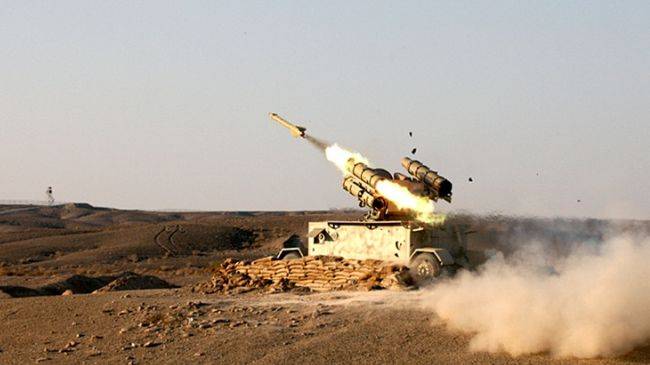
Unlike the Chinese HQ-7 ADMS mounted on light-armored wheeled vehicles, all elements of the export FM-80 are placed on a two-axle towed trailer. The FM-80 ADMS together with four ready-to-use missiles in massive TLCs include: a single-pulse target tracking radar, an optical-electronic module with a target tracking system and an infrared direction finder for automatic tracking of missiles.
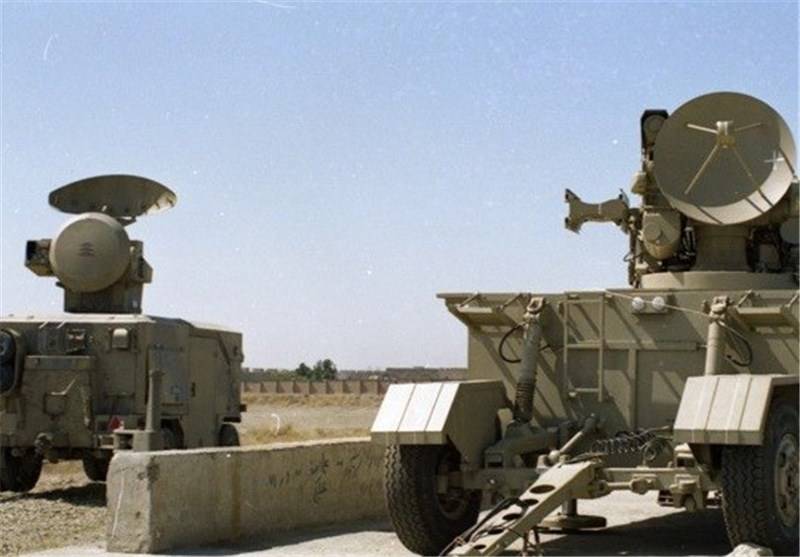
The diesel generator used as a power source is usually located on the truck-towing unit of the air defense system. The control cabin is located on another off-road truck or towed van.
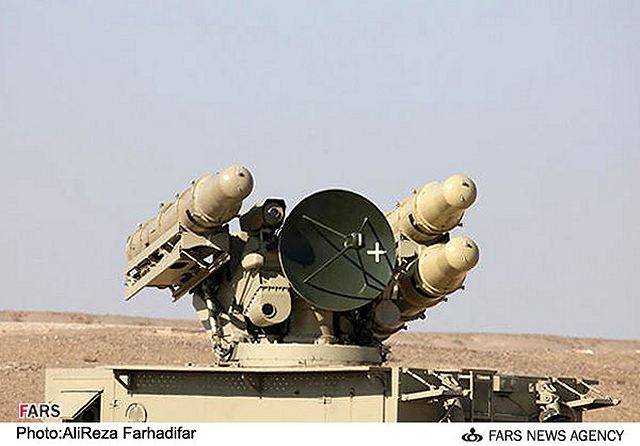
At the firing position, all elements of the air defense missile system are interconnected by cable lines. Radio targeting is provided by the Matla ul-Fajr or Kashef-2 radar. In Iran, the FM-80 SAM systems are often used together with paired 35-mm anti-aircraft guns, in this case, the complex includes Skyguard anti-aircraft fire control system.
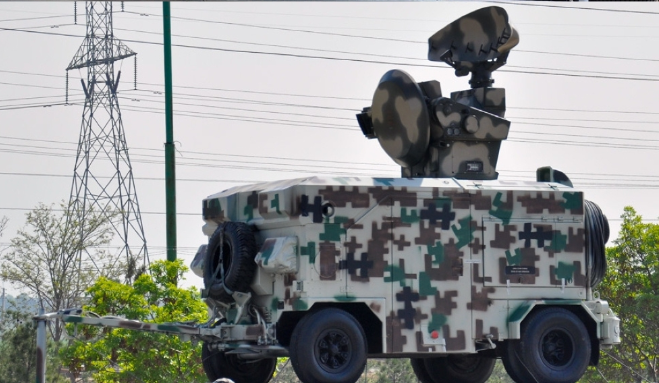
In 2013, the Herz-9 SAM system was presented in public, which also uses Shahab Thaqeb missiles. All elements of the complex are located on the wheelbase of the two-axle truck MAN 10-153, but at the same time the number of missiles in the WPK was reduced to two units.
After the appearance of the photos of Herz-9, most experts agreed that the Iranians managed to significantly reduce the size of the hardware of the complex and place all the elements of the air defense system on one chassis. But at the same time, due to the nature of placement of missiles, significant difficulties arise in recharging, and a special crane or manipulator will have to be introduced into the zenith battery. To date, there is no data on the adoption of the air defense system Herz-9 into service.
Of course, the most effective short-range anti-aircraft missile systems available in the armed forces of the Islamic Republic are the Tor combat vehicles. According to official data, in December 2005 of the year a contract was concluded worth $ 700 million for the supply of 29 X-TRUM M9 331X1 combat vehicles. Deliveries of "Thors" in Iran began in the first half of 2006. According to Sergey Chemezov, Rosoboronexport Director General, in January 2007, Russia fully fulfilled its obligations under this contract.
The combat capabilities of Tor-M1 are significantly increased compared with the early version of the complex. The Tor-M1 was the first Russian military air defense system with radar, which uses a phased antenna array with electronically controlled beam scanning. This constructive solution makes it possible to significantly reduce the reaction time and to produce, with high accuracy, automatic tracking and destruction of two targets simultaneously. High-performance computing tools based on specially developed algorithms, allowed to achieve full automation of the whole process of combat work, from the analysis of the air situation to the destruction of the target.
The 9K331 "Tor-M1" combat vehicle is a minimum unit capable of conducting combat operations autonomously - from detecting air targets to their destruction. To do this, the combat vehicle has its own means of detection, guidance and communications: detection radar, guidance and tracking station, a radar interrogator, a television-optical viewfinder, navigation equipment, aerial display, control of the functioning of the systems and facilities of the combat vehicle. Eight ready-to-launch missiles are located in the antenna-launch module. Vertical rocket launch is provided with a catapult device. The Tor-M1 air defense system is capable of destroying air targets (including high-precision weapons) with a probability of 0,5-0,99, at a distance of 1,5-12 km and an altitude of 0,01-6,0 km. The anti-aircraft missile battery includes 4 combat vehicles 9K331, battery command post 9С737М “Rangir-M”, transport-charging, transport and maintenance vehicles.
LAW "Tor-M1" uniquely are the best short-range complexes of the existing armed forces of Iran. But with high fire performance, a high probability of hitting a target, the ability to fight high-precision ammunition separated from carriers, high noise immunity and mobility, they still have a small range of damage and are unable to fight high-altitude targets. Which in turn makes it advisable to use them with long-range and high-altitude anti-aircraft systems.
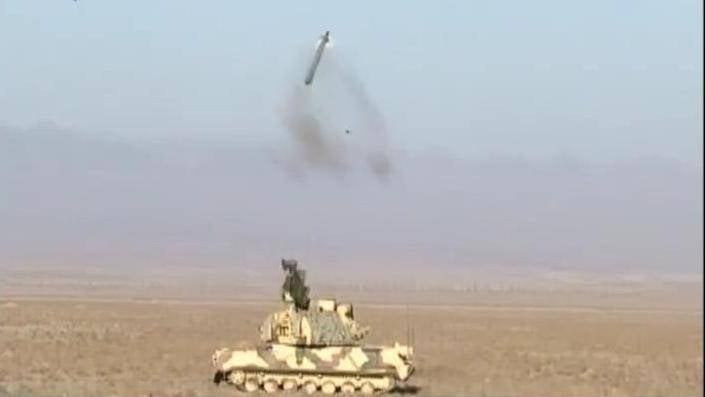
The Iranians deployed Tor-M1 batteries around their most important facilities. Russian complexes are considered as the last line of air defense in the event that air attack weapons are not hit by medium and long-range anti-aircraft systems. In August, a number of news agencies published 2010 information that the Iranian Tor-M1 shot down the F-4 fighter aircraft of the Iranian Air Force in the Bushehr nuclear power plant after the aircraft invaded the area around the nuclear power plant for unknown reasons. The pilot and navigator successfully catapulted and survived.
In an interview with Sergey Druzin, the deputy general director of the Almaz-Antey Air Defense Concern on scientific and technical development, given at the end of 2013, information was announced on the delivery of Tor-M2E air defense systems to Iran with new, more effective air defense systems. It is not known how this information is true, since Tor-M2E has not been demonstrated in Iran. But in the past, at various exhibitions of weapons, the Almaz-Antey concern repeatedly presented the Tor-M2E variant, made on the Belarusian-made MZKT-6922 wheeled chassis and painted in desert camouflage. According to Western sources, 1200 9М331 missiles were supplied to Iran with the Torahs.
According to the Jane Defense Weekly, in 2008, 10 anti-aircraft missile-gun systems “Pantsir-S1” were supplied to Iran through Syria. Iran sponsored the Syrian Arab Republic in concluding a contract for the purchase of ZRPK in 2006 year. The contract provided for the supply of 50 "armor" at the cost of one combat vehicle $ 13 million.
ZRPK "Pantsir-S1" with a combined missile and artillery armament is able to effectively deal with the most modern means of air attack at a distance of 20 km and an altitude of 15 km. The complex’s combat vehicle has 12 ready-to-use anti-aircraft missiles and 1400 30-mm projectiles. Air targets are detected by a three-coordinate radar of a circular view (based on PAR), the decimeter range with a range of work on large targets at medium altitudes up to 80 km. Targets with 2 m² EPR can be detected at a distance of 32-36 km. For tracking, a dual-band radar (mm + cm) is used, which ensures the operation of the complex for a wide class of targets. The millimeter-wave radar provides detection and destruction of targets with 0,1 square-wave EPR at a distance of up to 20 km. Capturing a target with an 2 EPR m² is possible at a distance of 30 km. The fire control system also includes an optoelectronic station capable of detecting and tracking airborne targets, as well as targeting missiles using an optical camera and a heat finder. The use of two independent means of guidance - radar and ECO - allows the capture and tracking of four targets simultaneously.
According to Western estimates, taking into account the supply of additional missiles, automated control systems, simulators and spare parts, the transaction amount was approximately $ 1 billion. Although all relevant directories relating to the state of the air defense of the Islamic Republic indicate the presence of Pankir-С1 in this country, in Iran itself This complex was not openly demonstrated.
In addition to short-range mobile complexes of own and foreign production, there are a considerable number of various types of MANPADS in the Iranian armed forces. According to observers, the outdated portable Strela-2M and the Chinese HN-5A are no longer used. However, the Strela-3 MANUAL and the Chinese QW-1 \ 1M are still in service (2006 units were supplied before the 1100 of the year).
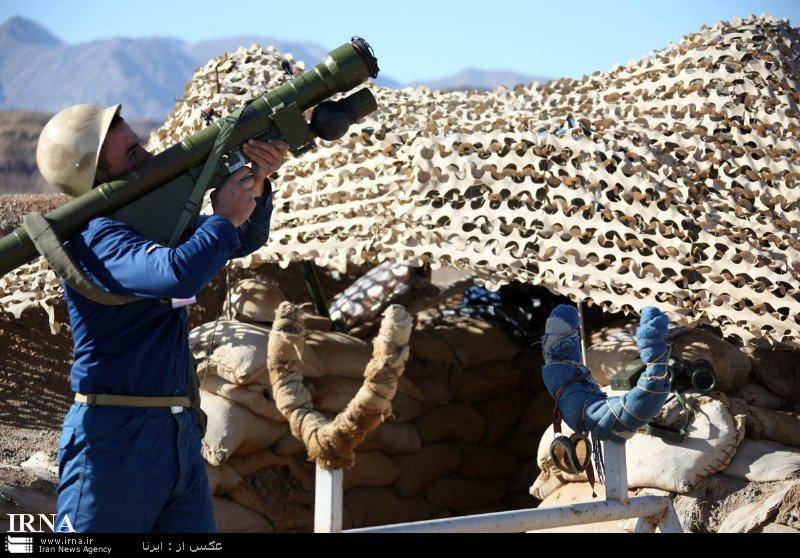
At the end of 80, Iran provided China with substantial assistance in creating modern MANPADS, buying from the Afghan Mujahideen a significant number of faulty FIM-92 Stinger. American complexes, delivered to the rebels to fight Soviet aircraft, after some time became unusable due to the failure of the batteries. Part of the acquired in the form of a faulty "second-hand" MANPADS, the Iranians reanimated and put into service (approximately 50 units), and a smaller part was sent to the PRC for study. After that, the Americans, who received information from their Afghan informants, caught on and began to actively redeem the remaining faulty Stingers. But it was already late, the American MANPADS proved to be put into service in Iran and became a source of inspiration for Chinese designers. Soviet Igla-1 MANPADS were captured by UNITA militants during the fighting in Angola and transferred to Zaire, where, in turn, they were sold to the PRC. As a result, QW-1992 - a conglomerate of the Russian "Needles-1" and the American "Stinger" was created in 1 in China. An improved version of the QW-1M has an improved sight and a rocket with the best aerodynamics. The QW-11 portable complex missile differs from the QW-1M with a more advanced homing head and the presence of a non-contact fuse, which makes it possible to fire targets flying at extremely low altitudes. According to some reports, Iran may have launched production of more modern portable Chinese QW-18 complexes, but the Iranians have no comment on this. The missile used in the QW-18 is equipped with a new two-spectral noise-suppressing seeker. Chinese QW-11 and QW-18 MANPADS are very similar in appearance, and it is difficult to distinguish them without detailed study.
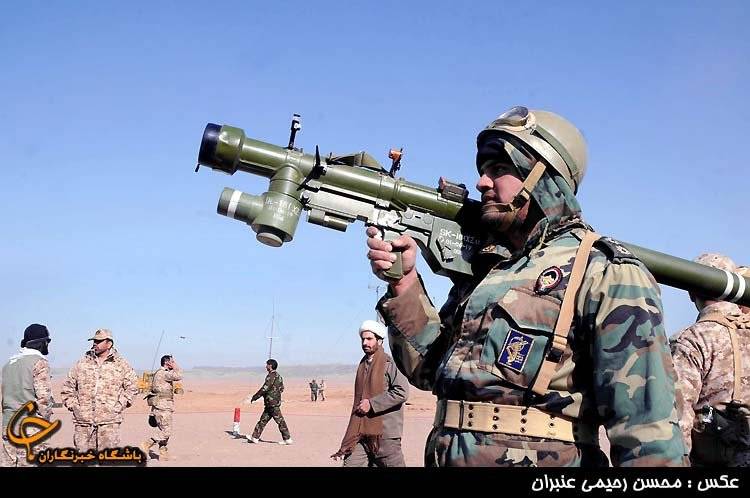
Production of Misagh-1 and Misagh-2 MANPADS was launched in Iran under a license obtained from the PRC. But what modifications of the Chinese complexes served as prototypes is not precisely known. According to its characteristics, Iranian Misagh-1 MANPADS fully comply with modern requirements. The sloping distance to the 500 target is 5000 m, and the XnUMX altitude reach is 30 m. The missile maximum speed is 4000 m / s. Weight of MANPADS - 600 kg. Mass of missiles - 16,9 kg. Mass of high-explosive fragmentation warhead - 10,7 kg.
In February 2017, Iranian news Irinn Channel announced the start of serial production of the new Misagh-3 MANPADS. Judging by the appearance, this is a further development of the early models of the Misagh family.
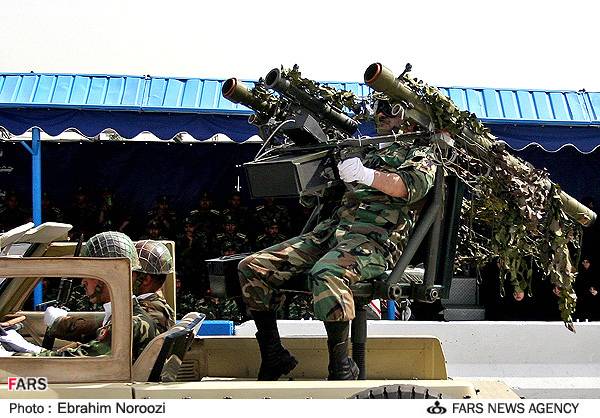
Apparently, supplies of Russian portable Igla complexes or their components were also delivered to Iran. During military parades in Tehran, coupled units placed on the chassis of off-road vehicles were repeatedly demonstrated. Outwardly, these “Sparky” MANPADS very strongly resemble the Russian Dzhigit reference-launcher. There can be more than 3500 MANPADS of various types in Iran.
At military parades regularly held in the Iranian capital, MANPADS on motorcycles and quads are constantly demonstrated. It is believed that this increases the mobility of portable complexes and allows you to quickly transfer shooters to threatened areas. However, driving over rough terrain with a 17 kg tube on the shoulder is from the field of circus tricks. What looks spectacular in a parade is often irrelevant to reality.
Iran remains one of the few countries where a significant amount of anti-aircraft artillery, including large caliber, is in service. Moreover, in the Islamic Republic, active work is still underway to create new types of anti-aircraft artillery systems of various types, which, apparently, is intended to compensate for the lack of modern anti-aircraft missile systems. As is known from the experience of local wars, anti-aircraft guns with massive use can create many problems even for aviation of a more technologically advanced adversary, since advanced electronic systems are not required for firing fire. In addition, air attack weapons that break through air defense systems at low altitudes are highly vulnerable to rapid-fire small-caliber anti-aircraft guns. In this case, in the event of preservation of the efficiency of the control system of the air defense units, a combination of the MPA and the air defense system can be very effective.
In the 2009, the automatic 100 mm Saeer anti-aircraft gun was demonstrated for the first time. This weapon, created on the basis of the Soviet post-war anti-aircraft gun KS-19, is induced and controlled centrally from the battery command post. Tools equipped with electric power tracking drives and an automatic charging system connected with an optoelectronic control system fire without the participation of personnel. With a range of 21 km air targets and 15 km altitude reachability, an anti-aircraft four-gun battery can launch 60 100-mm projectiles per minute on an XNUMX enemy.
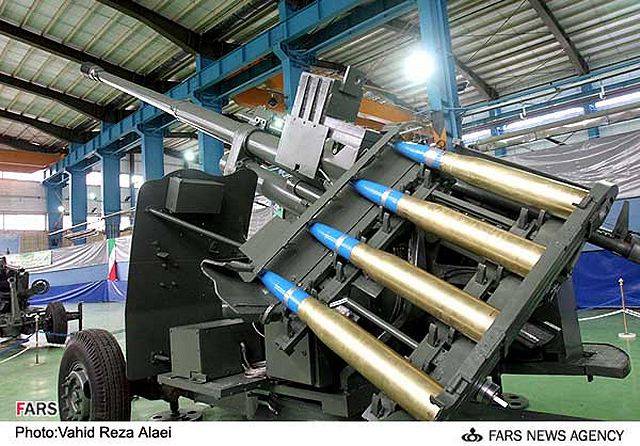
The introduction of "deserted technology" allows you to avoid losses among the calculations in the event that the enemy strikes the anti-aircraft battery during firing. Reduced cannon servants are needed only during the reloading of ammunition and the deployment or coagulation of the battery.
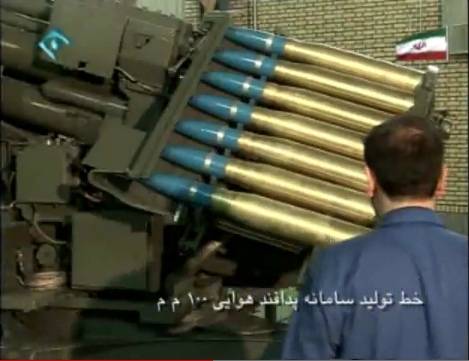
The gun shop has 7 shells ready for firing. Installing a remote fuse when shooting automatically. For an anti-aircraft gun of this caliber it would be advisable to create a projectile with a radar fuse, but it is not known whether such projectiles are part of the Iranian anti-aircraft guns. The official transfer of the first batch of Saeer 100-mm anti-aircraft guns to the troops took place in 2011 year. It is not clear whether the case was limited to an experienced party or a mass production of guns was established.
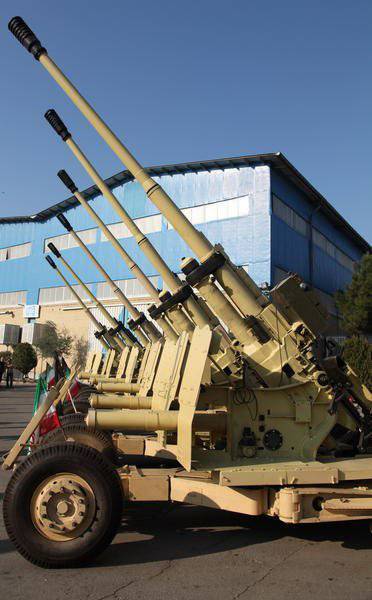
The KS-19 anti-aircraft gun, adopted by the USSR in 1949, is considered hopelessly outdated and the modernization attempt made in Iran is unlikely to be able to breathe new life into this artillery system. Modern anti-aircraft missile systems with similar indicators in range and altitude have a much higher probability of being hit, much more mobile, mask themselves better on the ground and require fewer calculations.
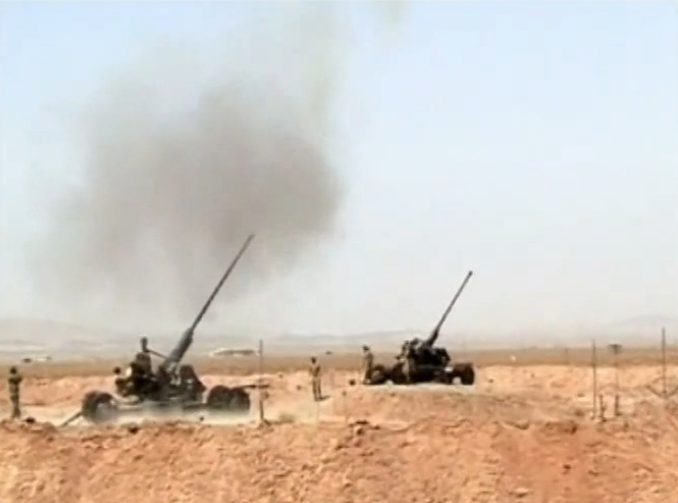
Iranian 57-mm anti-aircraft guns fire on aerial targets during 2009 exercises
Since 60-s of the last century, 57-mm anti-aircraft guns С-60 and ЗСУ-57-2 were in service with Iran. According to some reports, in the 57-mm towed anti-aircraft guns, the outdated fire control system was replaced by Iranian-made Skyguard OMS with an updated optical-electronic search and tracking system.
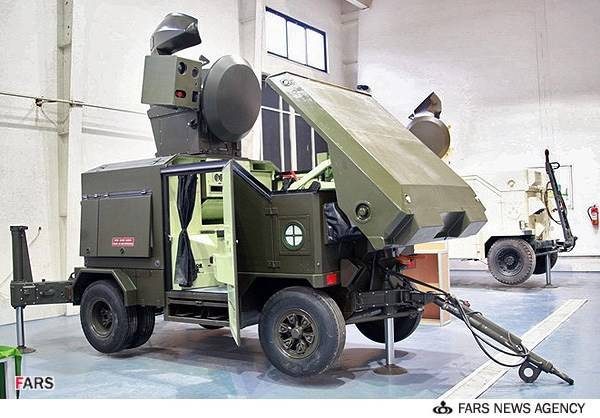
At the same time, in the last decade, the obsolete ZSU-57-2 are no longer shown at exercises and parades. Most likely, these self-propelled guns were transferred “for storage” or written off, due to their obsolescence and physical deterioration. In modern conditions, the effectiveness of the 57-mm sparks mounted on tank the chassis is more than doubtful due to the lack of a modern aiming system and a low practical rate of fire.
Nevertheless, in 2016, the Iranians demonstrated a Bachmann ZSU with two 57-mm guns on the KrAZ-6322 chassis. Most likely, this anti-aircraft gun is integrated with the Skyguard LMS, since otherwise there is no point in it, due to the low probability of hitting a rapidly moving target when manually installing sights.
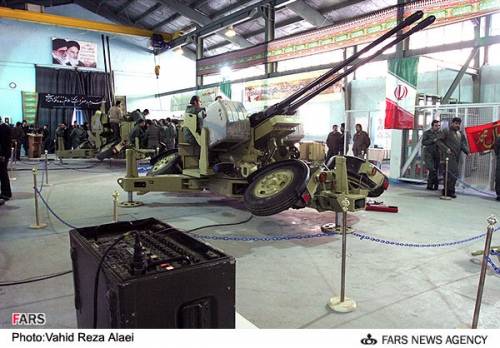
The most common and effective anti-aircraft artillery system is the 35-mm Oerlikon GDF-001 and its local version, known as Samavat. These settings completely replaced 37-mm 61-K and 40-mm Bofors L60. At the beginning of the 21 century, the Iranians not only upgraded the Swiss-made anti-aircraft machine, but also created a new optoelectronic search and tracking system based on the Skyguard JMA.
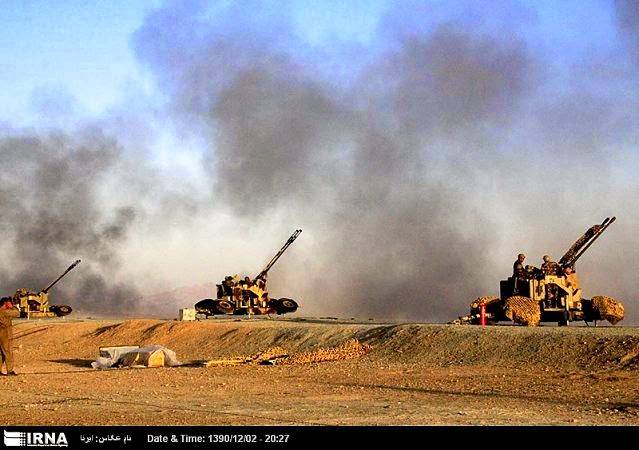
Due to the presence of electric servo drives 35-mm anti-aircraft guns can be aimed at the target remotely according to data from the fire control system. Each gun’s ammunition contains 112 projectiles ready to fire. The rate of fire of the paired anti-aircraft machine is 1100 rds / min., Which is a very good indicator for this caliber. The effective slant range for aerial targets is 4000 meters. The weight of the memory Samavat - 6,4 tons.
The number of 35-mm MZA in Iran is estimated at 1000 units, with about a third of the anti-aircraft installations deployed in fixed positions around strategic facilities. In the 2016 year, the 35-mm anti-aircraft guns opened fire twice on remote-controlled quadcopters approaching restricted areas.
Compared to the 35-mm MZA, the ZU-23 has more modest characteristics, but at the same time, the 23-mm paired anti-aircraft gun is much more compact, easier and cheaper. The ZU-23 installation can no longer be considered as a modern means of hitting air targets, but good performance and relatively low weight make 23-mm “zushku” in demand until now. An installation weighing tons of 0,95 is capable of hitting air targets at a distance of up to 2,5 km. Rate of fire to 1600 rds / min.
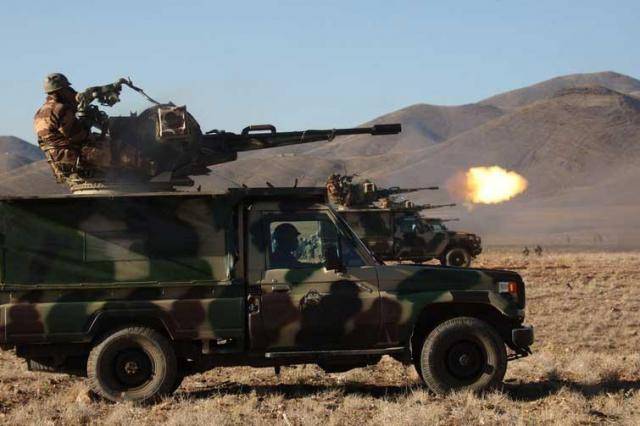
Due to the absence of a centralized control system in the anti-aircraft battery, the defeat of modern high-speed targets is possible only with barrage fire with a probability of 0,01 per gun. At the same time, in the Iranian armed forces, the ZU-23 is regarded as an effective means of fire support for land units and is widely installed on various wheeled and tracked chassis.
To improve the efficiency of 23-mm installations in Iran, a program of their modernization was launched. The increase in combat effectiveness was supposed to be carried out in two directions: an increase in the rate of fire and the introduction of a centralized SMS in the battery and guidance drives. In the Iranian media at the end of 90-x, frames were published that were taken during tests of “automated” ZU-23, remotely controlled without participation of calculations by a single guidance equipment. However, this development has not progressed further.
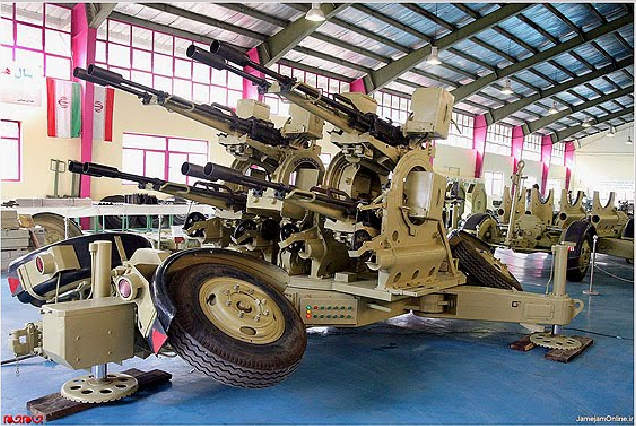
An attempt to increase the density of fire led to the creation of the monstrous eight-barreled installation Mesbah-1 on the carriage of the 35-mm Samavat anti-aircraft gun. Due to this, the possibility of aiming at the target without the participation of the calculation. In one second, the installation launches more 100 shells. Earlier, at the military parade, a six-barreled Mesbah storage unit was shown on a 57-mm C-60 artillery cart.
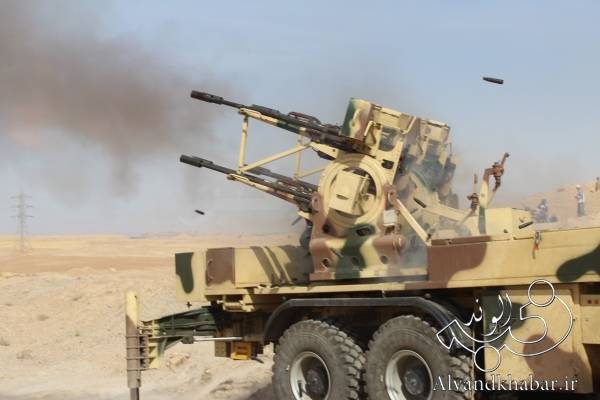
The Mesbah-1 anti-aircraft gun was first introduced at 2010 at the Iranian military-industrial complex. On Iranian television, the ZSU was also shown on the basis of a three-axle off-road truck, but there is no information about the adoption of the Mesbah-1.
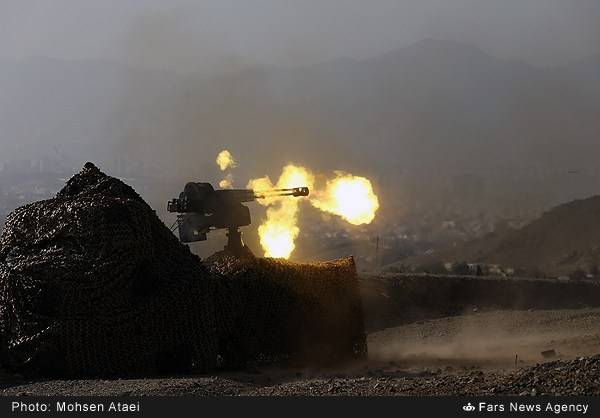
The other direction was the creation of the triple-barreled 23-mm Asefeh anti-aircraft system with a rotating block of barrels and a rate of fire of 900 rds / min But the rest of the characteristics and prospects of this weapons Significantly unknown. Judging by the available images, the weapon, made according to the Gatling scheme, is mounted on a self-propelled chassis and can be induced both in manual and automatic mode.
In Iran, several dozens of Shilka ZSU-23-4 are still in operation as part of the mechanized units. Part of the Iranian "Shilok" was repaired and upgraded at Iranian enterprises, after which they received the designation Soheil.
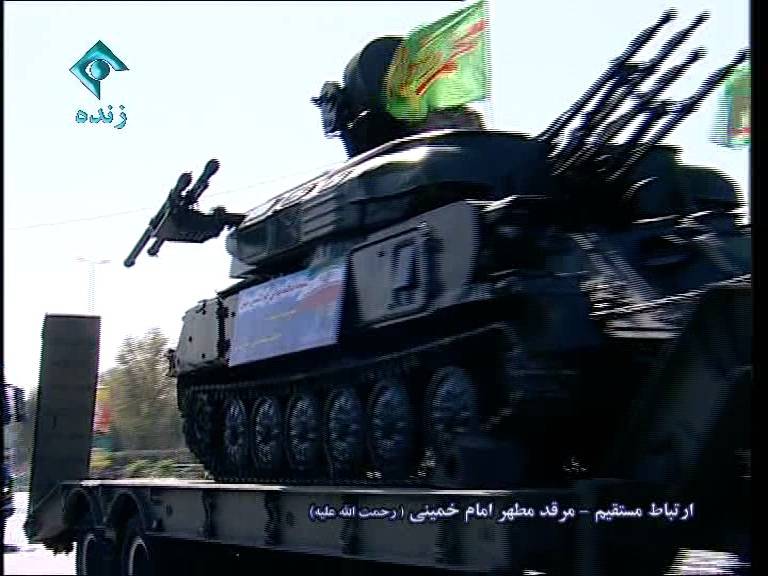
Replaced were: auxiliary power plant, radar equipment, information display screens and sights. The night thermal imaging channel was added to the sighting equipment, and two launch tubes for MANPADS appeared on the right side of the tower.
Until recently, the Iranian enterprise Individual Combat Industries Group under the designation MGD produced a 12,7-mm heavy machine gun DShKM. Currently, it is replaced in the production of a licensed copy of the Chinese W-85.
MGD and W-85 large-caliber machine guns mounted on all-terrain light vehicles are used as a mobile air defense system along with MANPADS. However, the practical rate of fire of machine guns is relatively low, which reduces the likelihood of hitting the target. To correct this deficiency, using the MGD, four and eight-barrel versions of anti-aircraft guns were created. The total rate of fire of eight machine guns DShKM is 4800 rds / min. The range of destruction of air targets - 2400 meters. A big disadvantage of multi-barrel installations is long and baggy recharging. Given the fact that the 12,7-mm machine guns are powered from boxes of 50 cartridges, they last for a few seconds of intense fire.
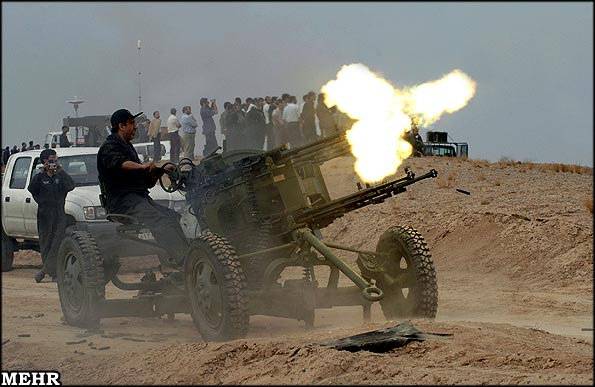
12,7-mm multi-barreled installations are intended to be replaced in the troops 14,5-mm ZPU-4. During the Iran-Iraq war, ZPU, in which Vladimirov's large-caliber machine guns are used, were captured in significant quantities as trophies. Perhaps a certain amount of ZPU-2 and ZPU-4 was obtained from Syria, the PRC or the DPRK. Since the production of 14,5-mm ammunition for this weapon is not conducted in the Islamic Republic of Iran, and the machine guns themselves are very worn out, they are being removed from service.
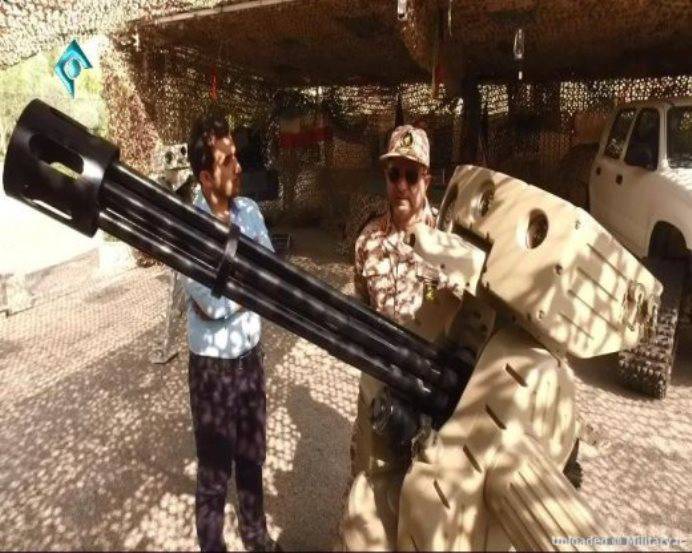
A much more high-tech and compact weapon is the 12,7-mm six-barreled Mukharam machine gun. It was first shown in 2014. According to Iranian media, this weapon is capable of making 30 shots per second. On the basis of the machine gun Mukharam created a remote-controlled 12,7-mm ZPU Nasir. The new anti-aircraft machine-gun unit is equipped with an optoelectronic aiming-search module and can be installed on different chassis or act independently on the field position. In this case, an electrically operated weapon is mounted on a tripod and connected to a remote control cable.
As can be seen, from all of the above, in the Islamic Republic, a great deal of attention is paid to the protection of ground forces units from air strikes. The number of developed anti-aircraft installations simply rolls over. Another issue is that a significant part of the Iranian air defense systems is based on the samples of a foreign production of the old-time 40-50 and cannot be considered modern. Simultaneously with the purchase of high-tech missile systems in Iran and Russia, Iran is saturating the troops with weapons of its own design, albeit not as effective, but at the same time massive and inexpensive to manufacture. Also noteworthy is the very high degree of readiness of the Iranian air defense units. Constant combat duty is carried not only by long-range anti-aircraft systems, but also short-range air defense systems and calculations of anti-aircraft guns.
To be continued ...
Based on:
http://defense-update.com/products/t/tor.htm
https://defence.pk/pdf/threads/irgc-unveils-fateh-assault-rifle-asefeh-23mm-gatling
http://www.turkishpress.com/news.asp?id=177315
https://sinodefence.com/army/surfacetoairmissile/qianwei1.asp
http://www.russiadefence.net/t4940p150-iran-air-defense-systems
http://globalmilitaryreview.blogspot.ru/2013/05/iran-test-fires-herz-9-short-range.html
https://defence.pk/pdf/threads/iranian-air-defense-systems.326173/page-25
http://theiranproject.com/blog/2012/11/13/iran-unveils-new-missile-systems-on-second-day-of-drills/
https://vpk.name/news/2637_rossiya_polnostyu_zavershila_vyipolnenie_kontrakta_na_postavku_v_iran_zrk_torm1.html
https://web.archive.org/web/20071018002847/http://janes.com/defence/news/jdw/jdw070522_1_n.shtml
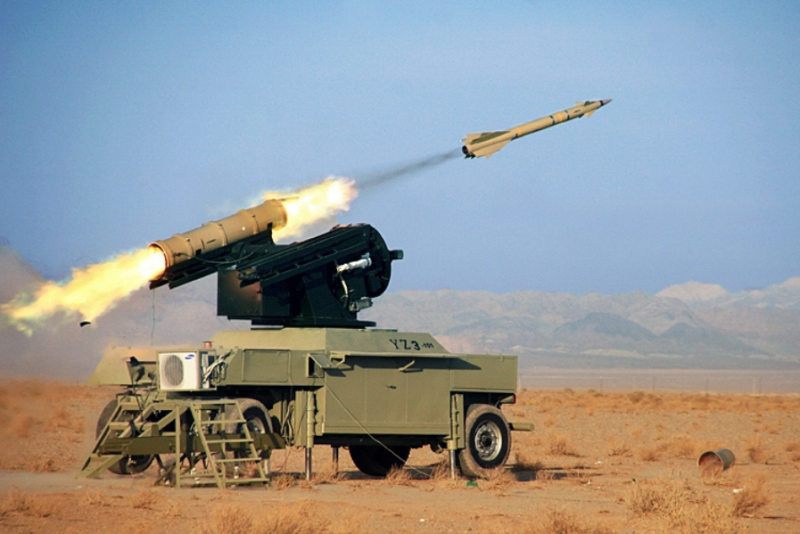
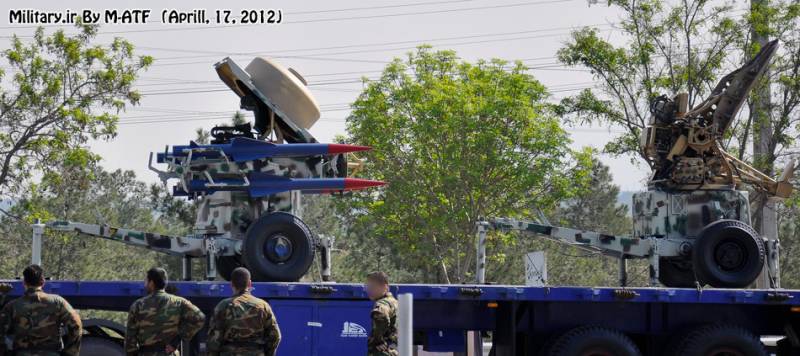
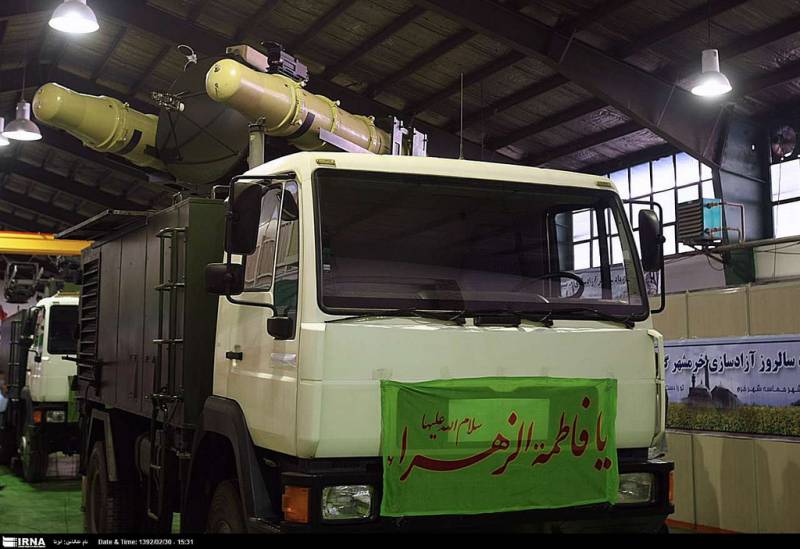
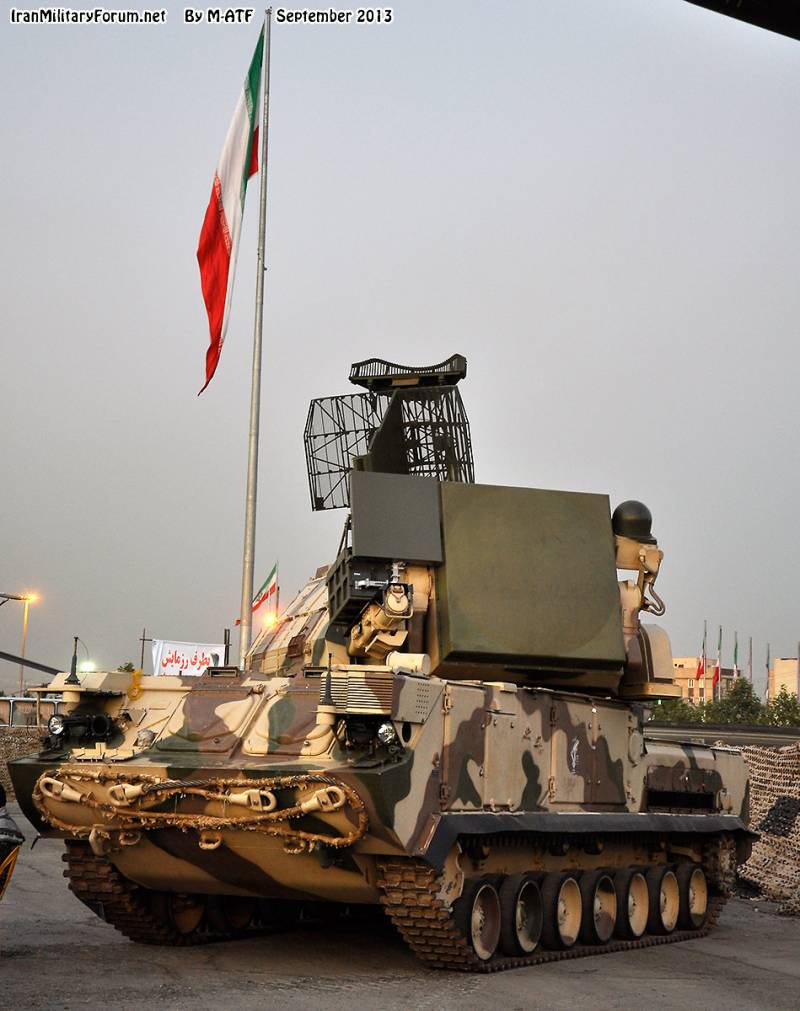
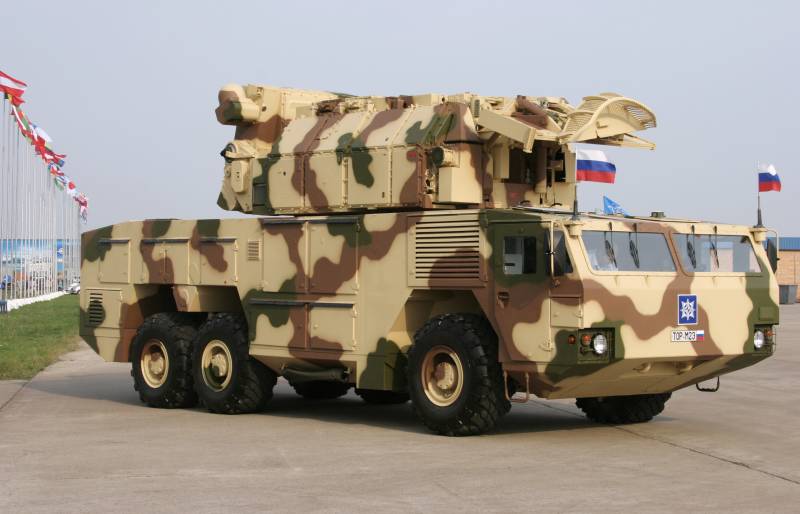
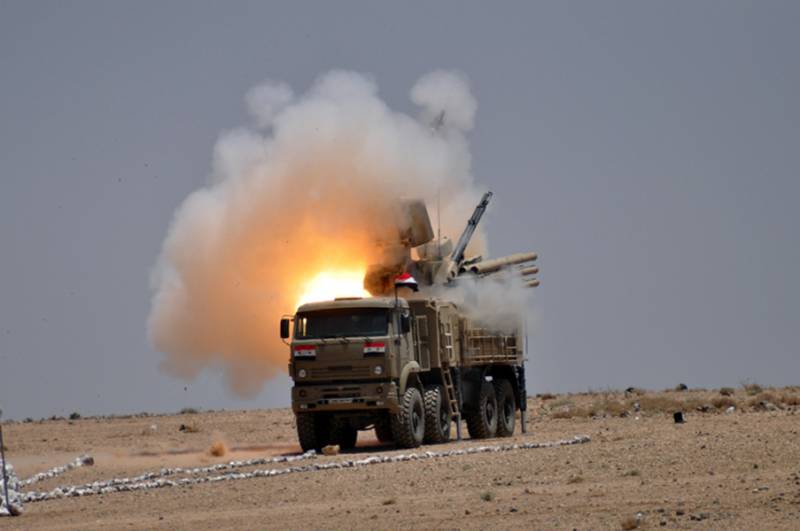
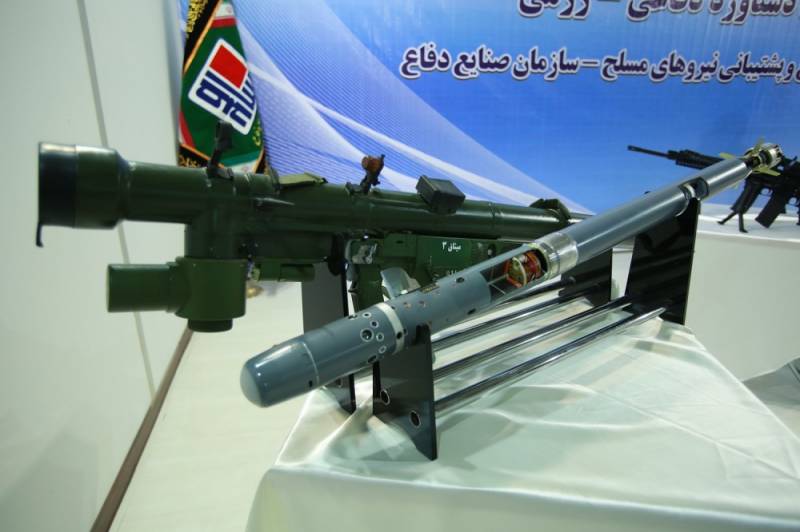
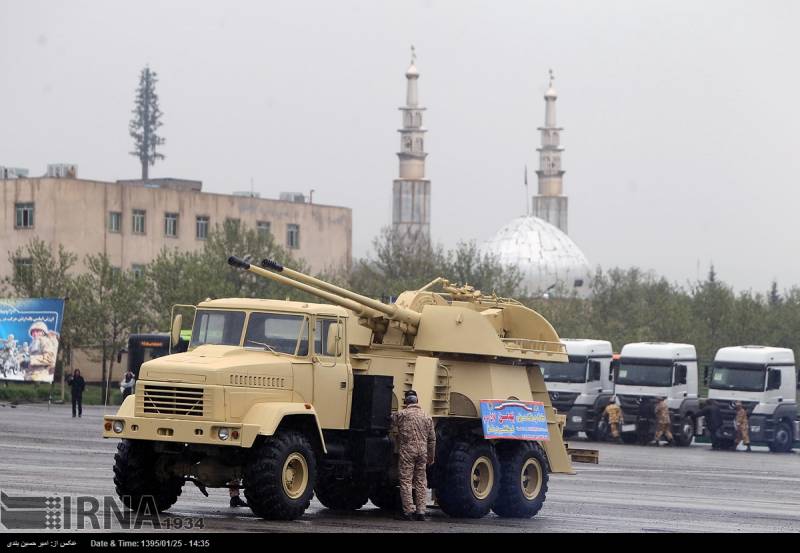
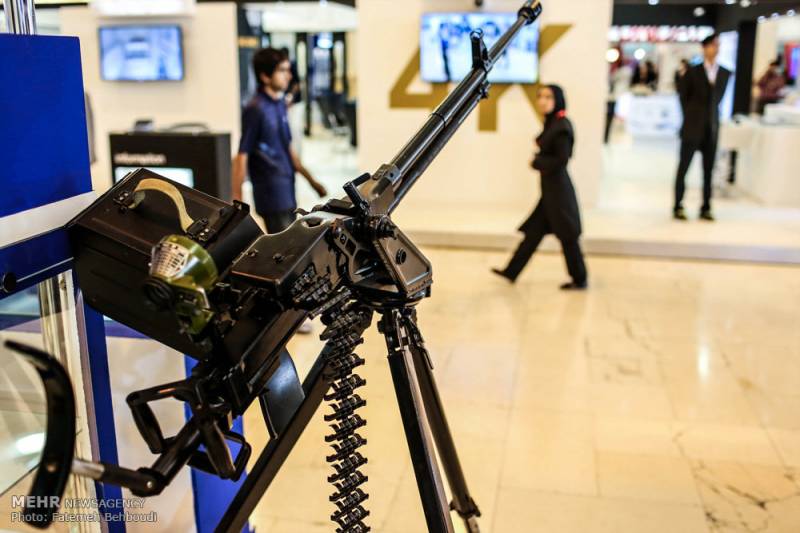
Information